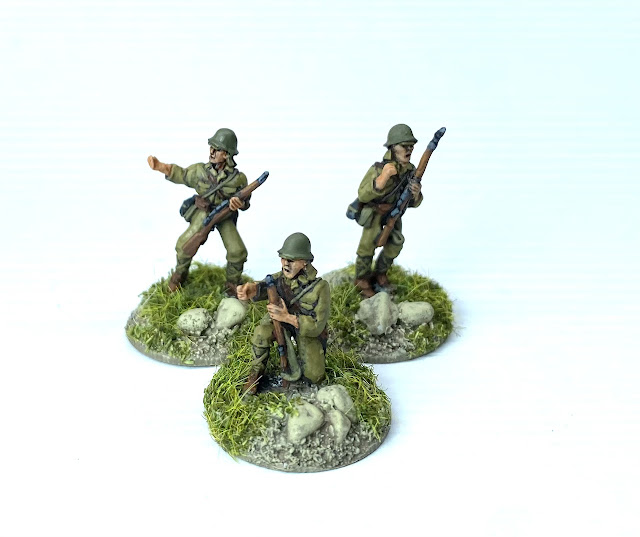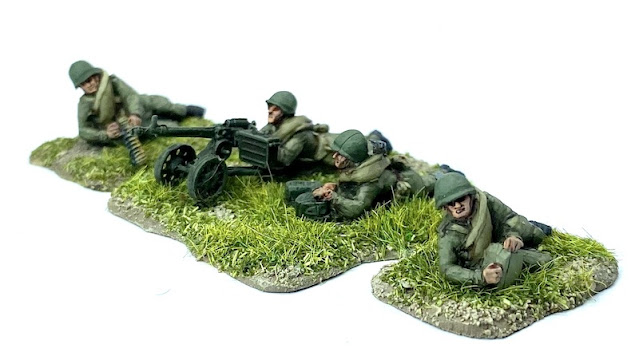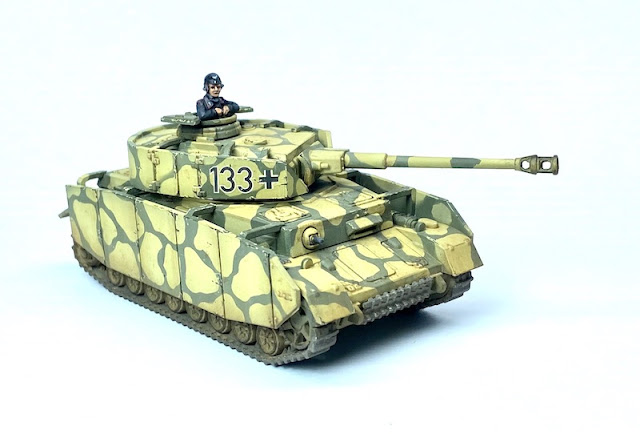When I first decided to return to miniatures I did so without an opponent or a club. I just felt the urge and worked in the hope that 'if you build it, they will come'. Having played hex and counter wargames for many years I had a circle of friends who I knew liked historical games, although whether they'd be interested in miniatures was another matter. So, on the basis that I would most probably have to provide everything I set about putting together opposing forces and terrain.
My primary interest has always been the Second World War and the initial task was to collect and paint enough figures and vehicles for a game. Delving back into miniatures after such a long break meant I spent a fair amount of time on the internet reading forums and blogs. I'd look with envy at posts where people showed off a new unit, perhaps something simple like an anti-tank gun and crew. It would force me to contemplate the lead and plastic pile I had accumulated and dream of the day when I'd be able to focus on simple, small additions. Well, that was nearly a decade ago and now there is no need to dream anymore, I'm in the enjoyable position of being able to do just that. Which is a long winded way of saying here's a post about several new additions and a bit of revamping of earlier parts of the collection.
My Second World War Japanese collection is reasonably comprehensive, but certainly not complete. I've been looking for figures with rifles to represent squad corporals. The figures I have are from Eureka and all have swords. I found some from SHQ and although I find their figures can be noticeably slimmer than those in other 20mm ranges I thought I would try them out.
The Japanese used the Type 94 Te Ke tankette extensively in China, but also in places like Malaya and Burma. While they would be obsolete in the context of a European battlefield their lightweight and mobility meant they remained useful in the Far East, seeing action in the Pacific as late as 1945. These three are all resin models from Milicast.
Tankette seems a most appropriate term for something so small. Here they are with a couple of figures to give a sense of scale and proportion (and yes, they are the
same scale!).
Staying with the Far East I discovered recently that the British 18 pounder gun was still in use at the start of the Second World War. A few modifications had been made to this iconic British gun from the Great War, the most obvious being a revised carriage and pneumatic wheels to allow them to be towed by vehicles rather than horses. These were sent to far flung outposts like Hong Kong and Malaya where they saw action following the Japanese invasions. I wanted to add one to my early war British force. The gun comes from SHQ and is crewed with a few of the AB Figures western desert force 25 pounder set.



Whilst we're on the subject of AB Figures and repurposing crews I did something similar for my Red Army collection. I had acquired a 12.7mm DHsK machine gun from MMS in anticipation of using it in our Westwind Konigsberg campaign for Chain of Command. Unfortunately the crew figures that came with the gun were very small and unlike the SHQ Japanese I didn't think they would match up well with my existing miniatures. My original solution for that campaign had been to crew the gun with plastic figures for a Maxim MG from the PSC Soviet Heavy Weapons set, but I've never liked the seated figure they have for gun.

I decided to replace them with figures from the AB Maxim set which I much prefer, not least because they are firing the weapon prone.
There is a Market Garden supplement for Chain of Command in the works. I'm interested in that campaign but also the later actions in Holland and then into Germany the following year. In anticipation of that I've been adding to my British force for that latter part of the war in NW Europe.
The Archer self propelled gun used a Valentine chassis to mount a 17 pounder anti-tank gun. It's a quirky looking vehicle, not least because the gun faces the rear, yet it served its purpose well enough. This is a resin and metal kit from Early War Miniatures. The crew figures come from the AB 17 pounder set.
Another mounting a 17 pounder was the M10, also known as the Achilles, a British adaptation of the US M10 (Wolverine). This is a plastic kit from Armourfast with a crew from AB. The Armourfast kits are cheap and robust but can be a bit short on detail, nothing that can't be addressed with stowage and a crew. I've gone one step further with this one and added camouflage netting.
While I was making the netting I took the opportunity to upgrade one of my earlier Cromwell models, also a kit from Armourfast. The same as with the Achilles I've added a crew figure from AB, stowage and camouflage netting. It's surprising how much these extra details lift a model and give it a character all of its own.
The plastic kits from the Plastic Soldier Company have more detail than those from Armourfast, but they are often very chunky and over scale. It's the price you pay for a model that is robust enough for gaming. One of the most glaring offenders is the bow machine gun on several of their tanks. The Sherman being a prime example with a barrel more like a piece of plumbers pipe as you can see below.
Sgts Mess produce a very useful set of barrels which are ideal for upgrading these kits. While I was doing that I took the opportunity to add a few pieces of stowage on the rear engine deck.
Their T34 has similar issues with the bow machine gun.
A set of replacement barrels from Sgts Mess helped out here. It may be a small difference and not one you notice from normal gaming distance, but it's one of those things that really stands out when I'm doing photographs for the AARs.
I've also gone back and made a few tweaks to a few earlier German tanks by adding new crew figures from AB.
























This is inspirational work! I have a few Armourfast kits in my 20mm WWII collection and they definitely need some crew added, particularly to the Achilles...but you have done a far better job than I did on mine!
ReplyDeleteThanks, it’s often those small details that can lift the simpler kits like those from Armourfast.
DeleteIt is paying attention to the little details that can make a good model pop, or raise an average model up to stand out from the crowd.
ReplyDeleteThanks Ashley, totally agree.
DeleteReal attention to detail certainly paid off on you upgrades and additions. Thanks for sharing, great resource sharing as well.
ReplyDeleteThanks!
DeleteEverything looks fantastic as your figures and vehicles always do. However, what inspired me most in this post is the fact that it took you a decade to get to this point. It's all too easy, when looking at a magazine or blog post, to forget that miniature wargaming is a long game. It takes patience and persistence over a period of time, however long (whether it's months or decades it's not instant). I think that's an important lesson for newcomers to the hobby and a reminder for the rest of us.
ReplyDeleteThanks John. It doesn’t always feel like it’s been 10 years but you’re absolutely right, these things take time and somethings just can’t be rushed if you want them to look their best.
DeleteThat's a great collection of figures, there's so much detail. Top brushwork.
ReplyDeleteThanks Ray.
DeleteI hope you realise it's now your collection and blog that others drool over and dream about - with a touch of envy?
ReplyDeleteThanks Rob, I’ve never looked at it that way, but if they inspire people the way the work of others inspired me then hopefully that’s a good thing and can be my little contribution back to the hobby.
DeleteMost splendid additions and refurbs. One of the joys of WWII is you can add things at minimal cost that can alter a scenario, although without the guarantee of it effecting the outcome
ReplyDelete